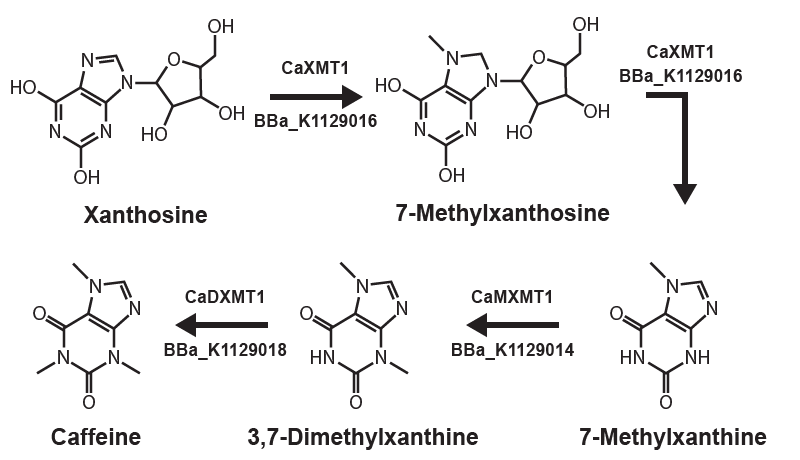Team:British Columbia/Project/Caffeine
From 2013.igem.org
(→Caffeine) |
AnnaMüller (Talk | contribs) (→Caffeine) |
||
| Line 3: | Line 3: | ||
=Caffeine= | =Caffeine= | ||
| - | Caffeine (1,3,7-trimethylxanthine) is arguably the most popular stimulant and psychoactive substance consumed in recent times. This is evident from the huge demand for coffee and tea beverages and increasingly energy drinks, all of which are common dietary sources of caffeine. Much research into caffeine’s effects on health and cost-effective methods of production have followed the trend of increasing consumption. Currently, methods of isolating caffeine for use as an additive include the decaffeination of commercially harvested plants, such as green tea leaves and Coffea arabica beans. This is an expensive process involving valuable arable land and large quantities of organic solvents or water, or specialized techniques such as supercritical fluid extraction with carbon dioxide. | + | Caffeine (1,3,7-trimethylxanthine) is arguably the most popular stimulant and psychoactive substance consumed in recent times. This is evident from the huge demand for coffee and tea beverages and increasingly energy drinks, all of which are common dietary sources of caffeine. Much research into caffeine’s effects on health and cost-effective methods of production have followed the trend of increasing consumption. Currently, methods of isolating caffeine for use as an additive include the decaffeination of commercially harvested plants, such as green tea leaves and <italics>Coffea arabica</italics> beans. This is an expensive process involving valuable arable land and large quantities of organic solvents or water, or specialized techniques such as supercritical fluid extraction with carbon dioxide. |
The ecological and financial burden of current caffeine production methods makes an alternative approach (microbial synthesis via synthetic biology) desirable. While there has been significant research done on the degradation of caffeine using microbes, synthesizing caffeine in a biological chassis is less common in the literature. Our goal was to implement the caffeine biosynthetic pathway (using xanthine as substrate) in E. coli to enable the production of caffeine in a bioreactor. This is largely building on the work of the [https://2012.igem.org/Team:TU_Munich 2012 TU Munich team], which successfully got caffeine precursors expressed in yeast. | The ecological and financial burden of current caffeine production methods makes an alternative approach (microbial synthesis via synthetic biology) desirable. While there has been significant research done on the degradation of caffeine using microbes, synthesizing caffeine in a biological chassis is less common in the literature. Our goal was to implement the caffeine biosynthetic pathway (using xanthine as substrate) in E. coli to enable the production of caffeine in a bioreactor. This is largely building on the work of the [https://2012.igem.org/Team:TU_Munich 2012 TU Munich team], which successfully got caffeine precursors expressed in yeast. | ||
Revision as of 03:50, 27 September 2013
iGEM Home


Caffeine
Caffeine (1,3,7-trimethylxanthine) is arguably the most popular stimulant and psychoactive substance consumed in recent times. This is evident from the huge demand for coffee and tea beverages and increasingly energy drinks, all of which are common dietary sources of caffeine. Much research into caffeine’s effects on health and cost-effective methods of production have followed the trend of increasing consumption. Currently, methods of isolating caffeine for use as an additive include the decaffeination of commercially harvested plants, such as green tea leaves and <italics>Coffea arabica</italics> beans. This is an expensive process involving valuable arable land and large quantities of organic solvents or water, or specialized techniques such as supercritical fluid extraction with carbon dioxide.
The ecological and financial burden of current caffeine production methods makes an alternative approach (microbial synthesis via synthetic biology) desirable. While there has been significant research done on the degradation of caffeine using microbes, synthesizing caffeine in a biological chassis is less common in the literature. Our goal was to implement the caffeine biosynthetic pathway (using xanthine as substrate) in E. coli to enable the production of caffeine in a bioreactor. This is largely building on the work of the 2012 TU Munich team, which successfully got caffeine precursors expressed in yeast.
Tying in with the immunization of bioreactors using the CRISPR system, the caffeine biosynthetic pathway serves as part of a proof-of-concept showing that the CRISPR system could be used to alter population dynamics in bioreactors.
 "
"
